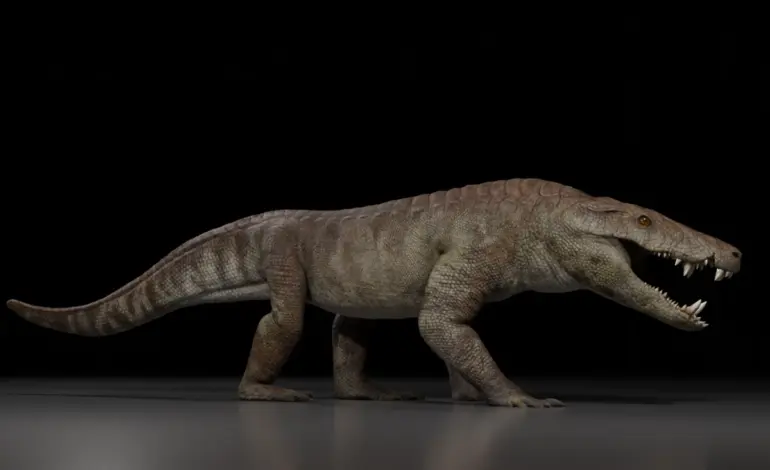Ancient Croc Skeleton Discovered in Argentina Reveals New Predator

A remarkably intact skeleton of a giant meat-eating crocodile relative has been discovered in Argentina, shedding light on its physiology and behavior from 70 million years ago. This significant find, unearthed near El Calafate, was part of an international research effort led by scientists from the Museo Argentino de Ciencias Naturales (MACN). The newly identified species, named Kostensuchus atrox, was a formidable predator that likely preyed on medium-sized dinosaurs during the late Cretaceous period.
The skeleton, which includes an almost complete skull and jaws, provides the most comprehensive look yet at a group of extinct crocodyliforms known as peirosaurids. These creatures coexisted with various species, including giant snakes, turtles, early birds, and small mammals, just before the catastrophic asteroid impact that marked the end of the Cretaceous.
Insights into Physiology and Behavior
Kostensuchus atrox is estimated to have reached lengths of approximately 3.5 meters (11.5 feet) and weighed around 250 kilograms (551 pounds). Its anatomy reveals a short, deep skull that supported powerful jaw muscles, along with blade-like, serrated teeth designed for slicing flesh. These characteristics classify it as a “hypercarnivore,” indicating that its diet consisted almost exclusively of meat.
The name Kostensuchus pays homage to both Patagonian heritage and ancient mythology. “Kosten” is derived from the Aonikenk (Tehuelche) term for the powerful winds of Patagonia, while “suchus” references the Greek god Sebek, who is depicted as a crocodile. The term “atrox” translates to “harsh” in Greek, highlighting the predatory nature of this species.
The discovery of this new genus marks a significant advancement in understanding the evolutionary history of crocodyliforms. Previous knowledge of peirosaurids was limited to fragmented remains, primarily isolated teeth. The articulated skeleton of K. atrox provides vital data for phylogenetic analyses, allowing researchers to better understand the relationships among broad-snouted peirosaurids and other related groups.
Ecological Context and Significance
Researchers have concluded that K. atrox was well adapted for a terrestrial lifestyle, contrasting with modern crocodiles that typically ambush prey from water. Its robust build and specialized dentition suggest it was an active hunter capable of taking on various animals directly, including dinosaurs that shared its habitat. Fossils of medium-sized herbivores and smaller carnivorous dinosaurs have also been found in the same rock layers, indicating that these crocodyliforms occupied a top position in the food chain.
The discovery from the Maastrichtian Chorrillo Formation enriches our understanding of the ecosystems in Patagonia just before the mass extinction event. While dinosaurs were the predominant predators of the time, creatures like K. atrox would have competed for resources and territory.
The researchers noted, “The discovery of Kostensuchus atrox considerably expands the knowledge about the anatomy of broad-snouted peirosaurids, which were previously known only from extremely fragmentary remains.” This finding provides a crucial benchmark for future studies, enhancing our understanding of how diverse crocodyliforms were during the late Cretaceous.
The study detailing this discovery has been published in the journal PLOS One, providing a foundation for further exploration into the evolutionary trajectories of ancient reptiles. As the last survivors of a once diverse lineage, today’s crocodiles, alligators, and gharials offer a glimpse into the adaptations and ecological roles of their prehistoric relatives.






